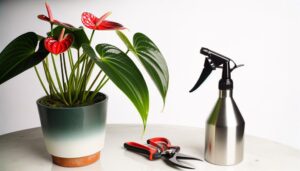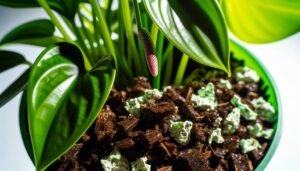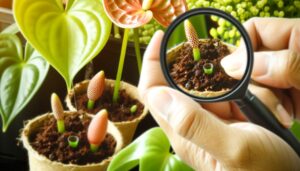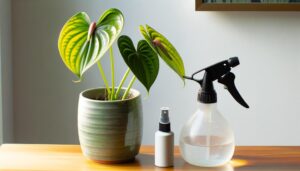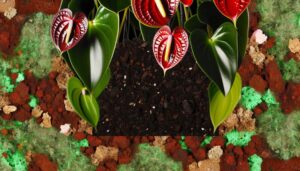10 Easy Care Tips for Anthurium Plants
To keep your Anthurium thriving, start with a well-draining pot with breathable material. Position it in bright, indirect light, avoiding direct sunlight.
Water when the top inch of soil is dry, using room temperature water. Maintain humidity between 60-80% and use a balanced fertilizer every 6-8 weeks.
Use a mix of orchid bark, peat moss, and perlite for soil. Regularly prune dead leaves and inspect for pests.
Keep temperatures between 65-80°F. Repot every 2-3 years and trim dead roots.
These strategies establish robust Anthurium health and growth—you’d be surprised at how easy it can be.

Key Takeaways
- Use a well-draining potting mix of orchid bark, peat moss, and perlite for optimal root health.
- Water when the top inch of soil is dry using room temperature water.
- Provide bright, indirect light to avoid leaf scorch and promote healthy growth.
- Maintain humidity levels between 60% to 80% with a hygrometer or humidifier.
- Fertilize every 6-8 weeks during the growing season with a balanced, water-soluble fertilizer.
Choose the Right Pot

Choosing the right pot for your Anthurium is essential to ensuring ideal root health and growth. You’ll want to select a pot with adequate drainage holes to prevent waterlogging, which can lead to root rot.
A pot made of breathable material, like terracotta, allows for better aeration and moisture regulation.
Make sure the pot’s size accommodates the plant’s root system but isn’t excessively large, as oversized pots retain too much moisture. Opt for a container that’s about 1-2 inches wider than the root ball.
Regularly check the drainage holes for blockages, ensuring consistent water flow. By carefully selecting the right pot, you’re fostering a thriving environment, allowing the Anthurium to develop robustly and serve its aesthetic and air-purifying roles efficiently.
Provide Adequate Light
Make sure your Anthurium plant receives bright indirect light to promote peak growth and flowering.
Avoid placing the plant in direct sunlight, as this can cause leaf scorch. Maintain a consistent light source to keep the plant healthy and vibrant.
Bright Indirect Light
Anthurium plants thrive under bright, indirect light, which mimics their natural habitat under the canopy of tropical rainforests.
Position your Anthurium near a north or east-facing window where it can receive ample diffused light. This placement ensures photosynthesis without exposing the plant to harmful UV rays.
If natural light is insufficient, consider using full-spectrum grow lights. Make sure the light intensity is between 10,000 and 20,000 lux for peak growth.
Monitor leaf color and growth patterns as indicators of sufficient lighting. Pale leaves signify inadequate light, while yellowing suggests excessive exposure.
Avoid Direct Sunlight
Direct sunlight can scorch Anthurium leaves, so position the plant where it receives bright, indirect light to prevent damage and support healthy growth.
You should place your Anthurium near an east or north-facing window, as these locations provide ample illumination without direct exposure. If the light intensity is too high, consider using sheer curtains to soften the sunlight.
Monitoring leaf color and texture will help you assess light sufficiency. Pale or scorched leaves indicate excessive light, while dark green leaves may suggest insufficient light. Aim for a balance where leaves exhibit a vibrant green hue.
Consistent Light Source
Maintaining a consistent light source is vital for the best growth and flowering of your Anthurium plant. Aim to provide bright, indirect light, as direct sunlight can scorch the leaves. Position your plant near an east or north-facing window where it can receive sufficient diffused light.
If natural light is inadequate, consider using fluorescent grow lights, ensuring they’re on for about 12-16 hours daily.
Monitor the plant closely; leggy growth or lack of blooms may indicate insufficient light. Adjust the light source as needed to maintain ideal conditions.
Watering Schedule

To achieve perfect growth, water your Anthurium when the top inch of the soil feels parched to the touch.
This guarantees the plant receives sufficient moisture without becoming oversaturated, which can lead to root decay.
Consistency is crucial, so establish a regular watering regimen. Depending on your surroundings, this might be weekly or every other week. Use room temperature water to prevent shocking the roots.
| Soil Condition | Action Required | Frequency |
|---|---|---|
| Top inch arid | Water thoroughly | Weekly/Bi-weekly |
| Consistently moist | Reduce watering | Every 2 weeks |
| Soil compressed | Aerate and water | As needed |
| Oversaturated | Allow to dry out | Monitor daily |
| Roots visible | Repot and water | Annually |
Monitor your plant’s response and adjust your schedule to ensure peak hydration.
Humidity Levels
Maintain your Anthurium thrives by keeping a humidity level between 60% to 80%, which mimics its natural tropical habitat. Use a hygrometer to monitor humidity closely.
If levels drop below 60%, consider using a humidifier or a pebble tray with water to increase moisture in the air. Grouping plants together can also create a microenvironment with higher humidity.
Avoid placing your Anthurium near heating vents or air conditioners, as they can drastically reduce humidity levels. Misting the leaves regularly can provide temporary relief but shouldn’t replace other methods.
Ensuring adequate humidity prevents leaf browning and promotes vibrant growth, helping you address your Anthurium’s needs effectively. This approach guarantees ideal health and aesthetic appeal for your plant.
Fertilizing Tips
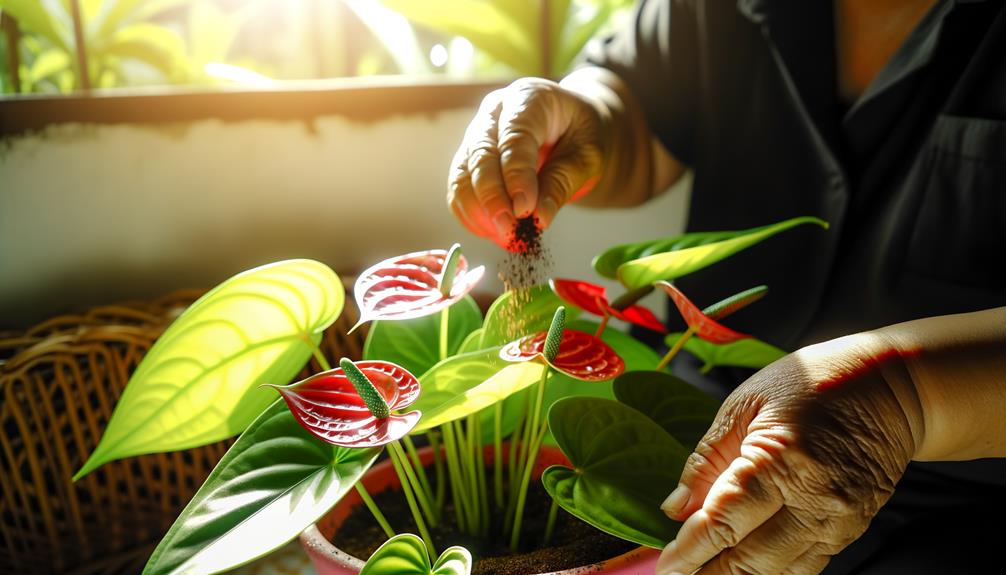
Proper nourishment is crucial for the robust growth and vibrant blooms of your Anthurium plant. Use a balanced, water-soluble fertilizer with a 20-20-20 NPK ratio. Dilute it to half strength, as excessive fertilization can harm the plant.
Apply the solution every six to eight weeks during the growing season, typically spring through early autumn. Ensure even distribution to avoid nutrient imbalances.
Monitor the plant for signs of nutrient deficiency, such as yellowing leaves, and adjust the nourishment schedule accordingly.
Incorporate organic matter like compost to enhance nutrient availability. Remember, consistent but moderate feeding supports the best health. Always water the plant thoroughly before and after nourishment to prevent root burn and promote efficient nutrient uptake.
Proper Soil Mix
Anthurium plants thrive best in a well-draining soil mix that combines equal parts of orchid bark, peat moss, and perlite. This specific blend guarantees optimal aeration and moisture retention, essential for the plant’s root health.
Here’s a precise breakdown:
- Orchid Bark: Enhances drainage and prevents root rot.
- Peat Moss: Retains moisture without becoming waterlogged.
- Perlite: Improves aeration and reduces soil compaction.
- Charcoal: Helps in detoxifying the soil and maintaining freshness.
Mix these components thoroughly to create a balanced environment that supports robust growth. Using the right soil mix not only promotes healthier plants but also makes your care routine more effective, ensuring you provide the best possible support for your anthuriums.
Pruning Techniques

When pruning your anthurium, focus on removing dead leaves to prevent disease and promote airflow.
Trim the plant for shape by cutting back overgrown stems just above a leaf node. Use sterilized pruning shears to minimize the risk of infection.
Removing Dead Leaves
To maintain a healthy Anthurium plant, regularly prune dead leaves using sterilized scissors or pruning shears. This practice prevents disease and encourages new growth.
Follow these steps for precise pruning:
- Identify: Look for yellowing, browning, or wilted leaves.
- Sterilize: Clean your tools with rubbing alcohol to prevent infection.
- Cut: Trim the leaf at its base, close to the stem, without damaging healthy tissue.
- Dispose: Remove the dead leaves from the area to prevent disease spread.
Trimming for Shape
Pruning your Anthurium for shape involves selectively trimming stems and leaves to encourage a balanced, aesthetically pleasing growth pattern. Begin by sterilizing your pruning shears to prevent disease transmission.
Target overgrown or leggy stems, cutting just above a leaf node to promote regrowth. Focus on removing any crossing branches to prevent crowding and enhance airflow.
Trim away any yellowing or damaged leaves, which can divert energy from healthy growth. Always make clean, precise cuts to minimize plant stress.
Regularly inspect your Anthurium and prune as needed, typically every few months. Consistent pruning not only maintains shape but also fosters ideal light penetration and nutrient distribution, ensuring your plant’s robust health and vibrant appearance.
Pest Control
Effective pest control for Anthurium plants involves regular inspection and prompt treatment to manage common pests like spider mites, aphids, and mealybugs. First, examine the leaves and stems weekly for any signs of infestation.
Second, isolate any affected plants to prevent the spread of pests.
Third, use insecticidal soap or neem oil as a primary treatment—these options are effective and eco-friendly.
Fourth, maintain proper ventilation and avoid overwatering, as damp conditions attract pests.
By following these steps, you’ll maintain the health and essentiality of your Anthurium plants, ensuring they continue to thrive and serve others as beautiful, low-maintenance additions to any space.
Regular vigilance and appropriate interventions are key to effective pest management.
Temperature Range
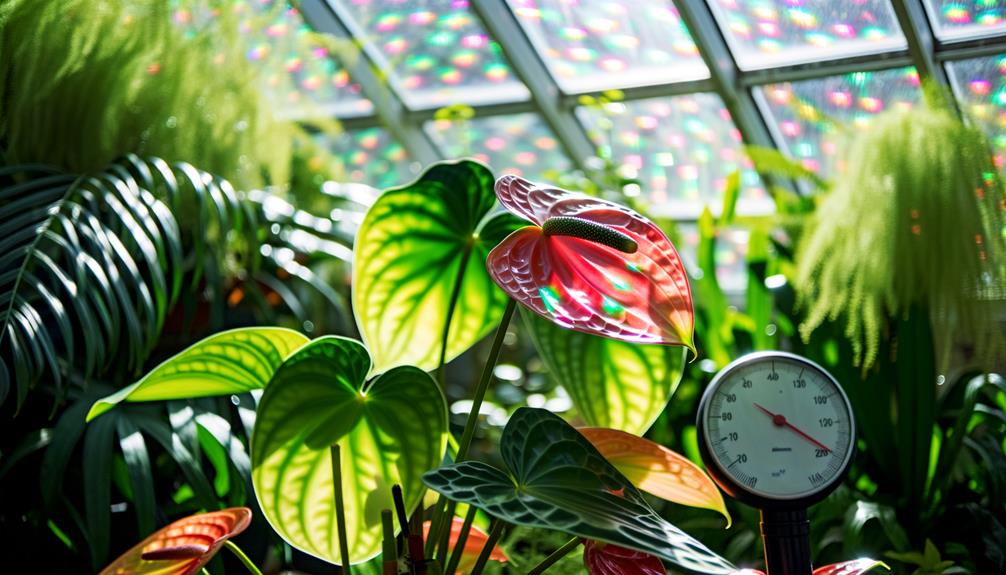
You should maintain a perfect temperature range for your Anthurium plants between 70-85°F (21-29°C) during the day and not below 60°F (15°C) at night.
Avoid exposing them to extreme temperatures, as fluctuations can stress the plant and hinder its growth.
Consistent warmth will guarantee excellent health and vibrant blooms.
Ideal Temperature Range
Anthurium plants flourish best in a temperature range of 65-80°F (18-27°C), which mimics their native tropical environment. To ensure peak growth and health, it’s essential to monitor and maintain consistent temperatures.
Here are four key points to keep in mind:
- Daytime Temperatures: Aim to keep daytime temperatures within 75-80°F (24-27°C).
- Nighttime Temperatures: Nighttime should ideally stay between 65-70°F (18-21°C).
- Humidity Levels: Maintain humidity levels around 60-80% to replicate tropical conditions.
- Temperature Fluctuations: Avoid sudden changes in temperature, as they can stress the plant.
Avoid Extreme Temperatures
Maintaining the perfect temperature range is crucial, but it’s equally important to avoid exposing your Anthurium plants to extreme temperatures that can severely hinder their growth. Anthuriums flourish in a temperature range of 65-80°F (18-27°C).
Temperatures below 55°F (13°C) can cause chilling injury, leading to stunted growth and leaf discoloration. Conversely, temperatures above 90°F (32°C) can cause heat stress, resulting in wilting and reduced photosynthetic efficiency.
Ensure your Anthurium is positioned away from drafty windows, heating vents, and direct sunlight to maintain stable conditions. Use a digital thermometer to monitor the ambient temperature closely.
Repotting Guidelines
Repotting your Anthurium every two to three years guarantees peak root health and vigorous growth. Choose a pot that’s 1-2 inches larger in diameter than the current one.
Use a well-draining potting mix, such as a blend of orchid bark, peat, and perlite. Follow these steps for best results:
- Prepare the new pot: Add a layer of fresh potting mix at the bottom.
- Remove the plant: Gently take the Anthurium out of its old pot, taking care not to damage the roots.
- Inspect the roots: Trim any dead or rotting roots with sterilized scissors.
- Plant and water: Place the Anthurium in the new pot, fill with potting mix, and water thoroughly.
This ensures your Anthurium thrives.
Conclusion
You’ve now got the essential tips to keep your anthurium thriving. Isn’t it satisfying to see your plant flourish with the correct care?
By selecting the appropriate pot, providing sufficient light, and maintaining proper humidity, you’re setting up an ideal environment.
Regular watering, fertilizing, and vigilant pest control further guarantee your plant’s health.
Remember, consistent temperature and timely repotting are key.
Follow these guidelines and watch your anthurium become a vibrant, enduring addition to your space.

